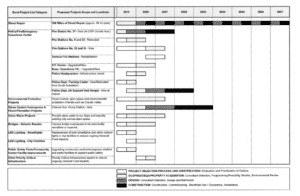As San Jose prepares to roll out millions of dollars in Measure T funding this summer, city leaders on Tuesday discussed their plans to divvy up the money across the city.
Measure T – a $650 million bond that was passed in November by nearly 70 percent of voters – is earmarked for public safety, infrastructure and disaster preparedness. The money, which will be spent in phases, is expected to fund the repair of hundreds of miles of roads, fix and seismically retrofit bridges and build two new fire stations, among other projects.
But while the bond funds a vast array of projects in all corners of the city, some residents and activists are calling on city administrators to dedicate $50 million to protect Coyote Valley.

“We want to allocate the full 50 and we need to do it early,” Kiyomi Honda Yamamoto, a representative from the eco-nonprofit Greenbelt Alliance, told San José Spotlight.
Coyote Valley is a 7,000-acre section of mostly undeveloped land in South San Jose. While the city once envisioned it as a potential industrial hub, the focus has now turned to preservation. Last month, the City Council held a study session where they heard from experts about the value of the land in a variety of aspects. Environmentalists stressed the benefits of the green infrastructure when it comes to flooding.
“Once you develop, the water sheaths off, it’s not absorbed anymore to the natural landscape,” said Andrea Mackenzie, the general manager at the Santa Clara Valley Open Space Authority. “It flows at faster velocity and in more volume downtown.”
Despite the call from the public and countless advocacy letters, City Attorney Rick Doyle said Tuesday was not the day for action on Coyote Valley. Doyle said the discussion was solely an update on the status of Measure T’s fund implementation, not to vote on allocating any money specifically.
With a push from Councilmember Sergio Jimenez, however, the council and city staff agreed to go into a closed session by Feb. 26 to discuss negotiations for acquiring North Coyote Valley for environmental protection.
Councilors also discussed a memo from Mayor Sam Liccardo and Councilmembers Raul Peralez, Lan Diep, Dev Davis and Johnny Khamis related to developing zero net carbon buildings for new projects. The memo, which was submitted late last week, asked staff to research best practices when it comes to sustainable design and construction.
An update on the final Measure T work plan is set to come back to the council in June for their approval before the bond’s issuance in July.
Closing San Jose’s ‘Digital Divide’
Earlier on Tuesday, Liccardo announced the launch of the city’s Digital Inclusion Fund.
The initiative, which is the largest in the country, aims to connect 50,000 households with broadband access and educate them on using technology over the next 10 years. It will help close the so-called digital divide – the separation between those who have access to internet at home and those who don’t.
The council unanimously approved negotiating an agreement with California Emerging Technology Fund. The nonprofit, which aims to close the digital divide in the state, will partner with the city to manage the revenue and create the inclusion fund. The money for the program will come from fees that telecommunications companies pay to place cells that deliver 5G networks in San Jose.
The initiative drew praise from most of the council Tuesday, with East Side Councilmember Magdalena Carrasco calling it a way to “level (the) playing field.”
The digital divide disproportionally affects the city’s low-income population. More than 60 percent of low-income families don’t have broadband access at home, according to city documents. The issue also greatly affects the city’s Latino population, with more than 35 percent of households lacking access.
Councilwoman Pam Foley, one of a few former school board members on the council, was supportive of the inclusivity of the program which largely focuses on students who lack adequate internet to complete their homework.
But when Foley mentioned the program’s inclusivity, she wasn’t talking about students. She was talking about another group stuck on the wrong side of the digital divide: Seniors.
“I know we’re going to be able to reach the students in a much easier way,” she said. “I worry about the seniors because they are nervous and intimidated.”
The city plans to start doling out the first $1 million of grants from the program this fall. They also plan to create an advisory board with local stakeholders to oversee the estimated $24 million in grants the program will draw.
Contact Grace Hase at [email protected] or follow @grace_hase on Twitter.



Leave a Reply
You must be logged in to post a comment.